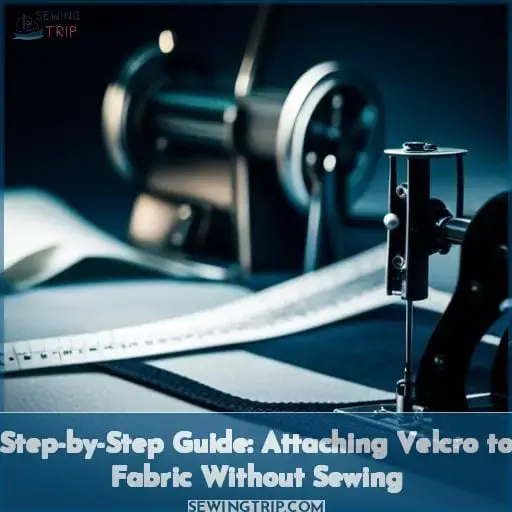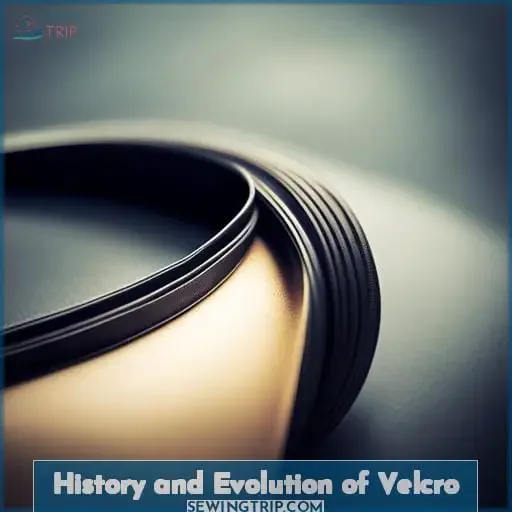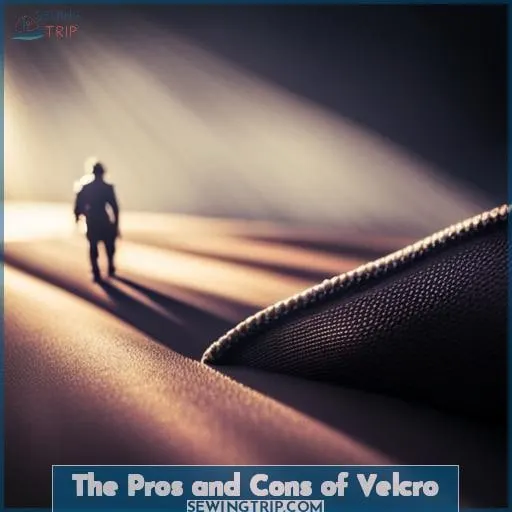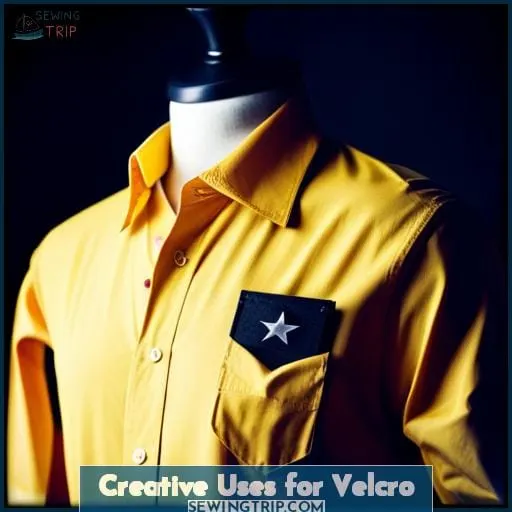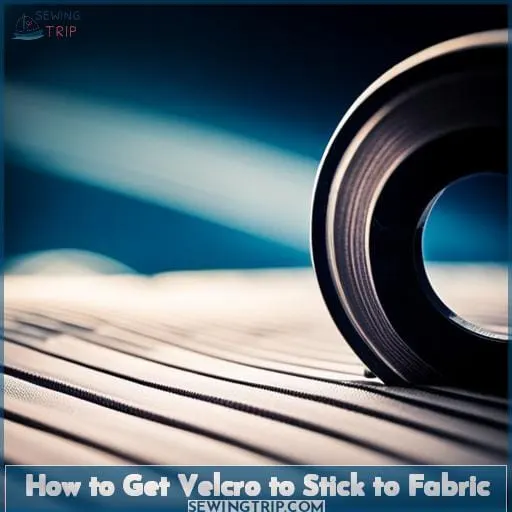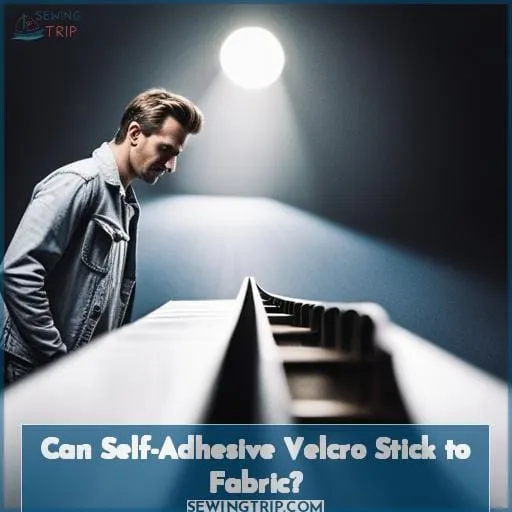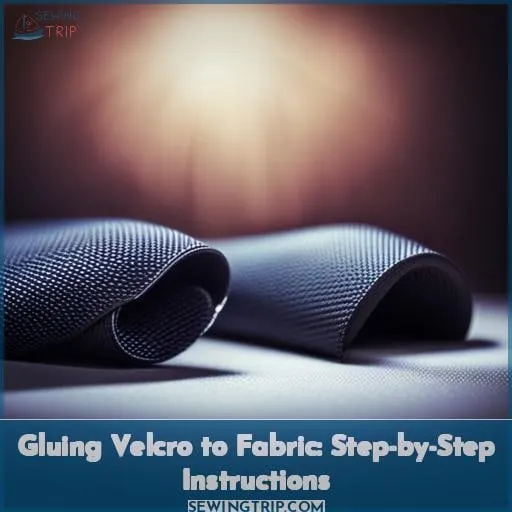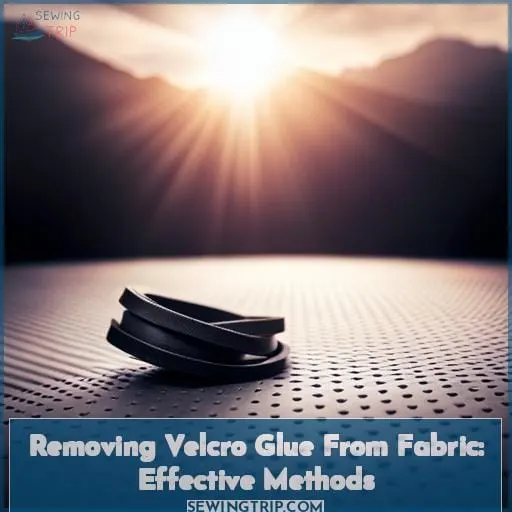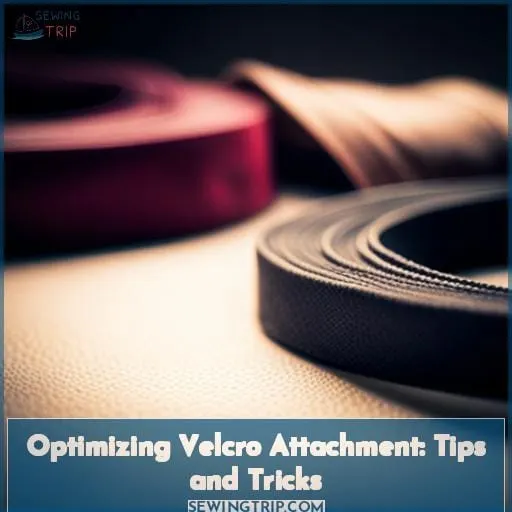This site is supported by our readers. We may earn a commission, at no cost to you, if you purchase through links.
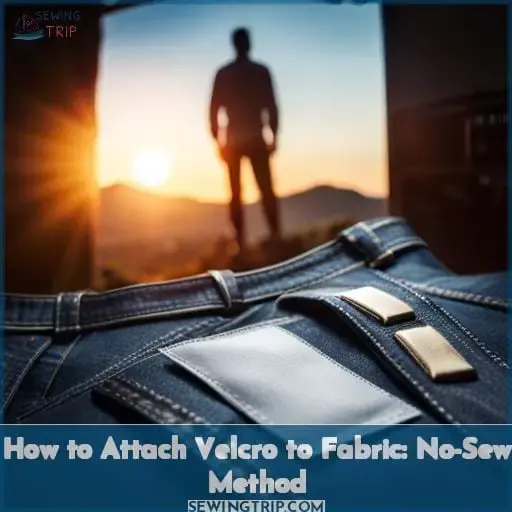 Imagine effortlessly attaching Velcro to fabric without the hassle of sewing. With our no-sew method, you can achieve a strong and secure bond in just a few simple steps. Say goodbye to needles and thread! By using adhesive options specifically designed for Velcro attachment, you’ll have your fabrics fastened together in no time.
Imagine effortlessly attaching Velcro to fabric without the hassle of sewing. With our no-sew method, you can achieve a strong and secure bond in just a few simple steps. Say goodbye to needles and thread! By using adhesive options specifically designed for Velcro attachment, you’ll have your fabrics fastened together in no time.
In this article, we will guide you through the process of attaching Velcro to fabric without sewing, giving you the freedom and power to create with ease.
Table Of Contents
- Key Takeaways
- Step-by-Step Guide: Attaching Velcro to Fabric Without Sewing
- History and Evolution of Velcro
- The Pros and Cons of Velcro
- Creative Uses for Velcro
- How to Get Velcro to Stick to Fabric
- Can Self-Adhesive Velcro Stick to Fabric?
- Gluing Velcro to Fabric: Step-by-Step Instructions
- Removing Velcro Glue From Fabric: Effective Methods
- Optimizing Velcro Attachment: Tips and Tricks
- Exploring Velcro’s Adhesive Properties: Waterproof and More
- Frequently Asked Questions (FAQs)
- Conclusion
Key Takeaways
- Choose an appropriate adhesive for attaching velcro to fabric, considering compatibility, surface preparation, bonding technique, and environmental impact
- Fabric tape, hot glue, self-adhesive velcro, and waterproof adhesives can be used as adhesives for velcro on fabric
- Prepare the fabric surface properly before attaching velcro with adhesive to maximize bond strength
- Consider creative non-sewing uses for velcro on fabric such as in gardening, cleaning, crafting, pet toys, or on shoes
Step-by-Step Guide: Attaching Velcro to Fabric Without Sewing
Now that you understand the purpose and benefits of attaching Velcro without sewing, let’s dive into the step-by-step guide.
This section will focus on adhesive options for Velcro and choosing the right adhesive for your fabric. By following these directions, you can achieve a secure bond between your fabric and hook-and-loop fasteners without having to sew.
Adhesive Options for Velcro
First, gather the necessary materials for attaching Velcro to fabric without sewing.
Here are some adhesive options to consider:
- Fabric tape: A peel-and-stick method that offers personalization and patch attachment.
- Hot glue: Quick application using a hot glue gun, requiring proper application and drying time.
- Self-adhesive Velcro: Works well with specific fabric adhesives for easy attachment.
- Waterproof adhesives: Ideal for use in water-contact items, ensuring durability even when exposed to moisture.
- Adhesive strength reinforcement methods: Stitching or using stronger adhesives like nails can enhance the bond.
Choose an adhesive option based on your desired fabric compatibility and project requirements.
Choosing the Right Adhesive
To ensure a secure and long-lasting attachment, it’s important to choose the right adhesive when attaching Velcro to fabric.
- The adhesive’s compatibility with your fabric
- Surface preparation
- Bonding techniques
- Environmental impact
- Application challenges
History and Evolution of Velcro
Curious how Velcro got its start? Learn more about the history and evolution of this innovative fastening system.
Velcro, a term coined from the words velvet and crochet, was invented by Swiss engineer George de Mestral in 1948. The discovery came after he noticed cockleburs sticking to his clothing during a hunting trip.
Intrigued, he examined these burrs under a microscope and discovered their hook-like structure that easily attached to fabric loops.
De Mestral’s fascination with this natural fastening mechanism led him on an eight-year journey of development before introducing the first commercial version made from cotton prototypes. However, it wasn’t until nylon became available in the early 1950s that Velcro truly took off due to its durability and versatility.
Over time, Velcro has found extensive applications across various industries beyond fabric crafts. Its medical uses include securing orthopedic braces and assisting in surgeries like artificial heart procedures.
In addition, automotive manufacturers utilize it for interior components while aerospace companies rely on it for secure panel attachment.
As demand grew exponentially since its introduction into industrial settings thanks to cost-effective manufacturing methods; different brands emerged offering variations of hook-and-loop fasteners suited for specific needs such as self-adhesive options or sew-on types.
The history of Velcro showcases how one accidental observation transformed into an indispensable innovation applicable across numerous fields today—a testament to human curiosity leading us towards liberation through understanding new possibilities offered by materials like nylon combined with simple yet powerful design principles embodied by hook-and-loop technology.
The Pros and Cons of Velcro
Velcro offers a variety of benefits for attaching fabric, including durability, versatility, and noise. However, it can also collect dirt and lint and be noisy in certain situations. Additionally, removing Velcro glue from fabric can be difficult.
Here are some of the pros and cons of using Velcro:
Pros:
- Durability: Velcro is a durable material that can withstand wear and tear.
- Versatility: Velcro can be used in a variety of applications, from clothing to shoes to home décor.
- Noise: Velcro makes a satisfying clicking sound when it’s engaged, which can be a security measure.
Cons:
- Collects dirt and lint: Velcro can collect dirt and lint, which can make it difficult to clean.
- Noise: Velcro can be noisy in certain situations, such as when it’s engaged in a crowded area.
- Removing Velcro glue: Removing Velcro glue from fabric can be difficult.
Overall, Velcro is a versatile and durable material that can be used in a variety of applications. However, it’s important to be aware of its potential drawbacks, such as the ability to collect dirt and lint and the difficulty of removing Velcro glue from fabric.
Creative Uses for Velcro
With endless creative potential, Velcro can be used for a variety of projects beyond its traditional applications.
- Gardening: Keep gardening tools organized by attaching Velcro strips to the inside of a shed or garage door.
- Cleaning: Use Velcro to attach cleaning cloths to a broom or mop handle for easy access.
- Crafting: Attach Velcro to fabric scraps to create unique collages or wall hangings.
- Pet Toys: Make fun and interactive pet toys by attaching Velcro to balls, plush toys, or other objects.
- Shoes: Keep your shoes from slipping off by attaching Velcro strips to the inside of the heel.
How to Get Velcro to Stick to Fabric
To ensure a secure bond between Velcro and fabric, follow these steps for getting the Velcro to stick without sewing:
-
Fabric Preparation:
- Before attaching the Velcro, make sure your fabric is clean and dry.
- Washing and drying the fabric beforehand will help optimize adhesive activation.
-
Adhesive Activation Time:
- Once you have cut your desired size of hook and loop fasteners, allow around 24 hours for the adhesive to set properly on both the fabric and Velcro surfaces.
- This thorough drying time ensures long-lasting results.
-
Firmly Pressing:
- When applying the no-sew Versatility method of attaching Velcro, firmly press it onto your prepared fabric surface with even pressure using your fingers or a smooth object such as a ruler or credit card.
- This step is crucial in achieving a secure bond.
-
Cautionary Note:
- While this no-sew method offers convenience, it’s important to avoid wearing or washing garments immediately after application as they need time to fully adhere together.
By following these steps for getting Velcoo To Stick To Fabric , you can enjoy hassle-free attachment that provides strength throughout use without any stitching required
Can Self-Adhesive Velcro Stick to Fabric?
Sure, self-adhesive Velcro can stick to fabric. It’s a reusable, washable, durable, and strong way to attach Velcro to fabric. However, it’s important to use the right adhesive and follow the instructions carefully to ensure a secure bond.
Gluing Velcro to Fabric: Step-by-Step Instructions
To glue Velcro to fabric,
- Apply glue carefully from the center to the edge, avoiding excess glue.
- Allow seam allowance to prevent glue spread.
- Follow drying time instructions.
- Consider reinforcing the bond with subsequent stitching.
Application Technique
Applying adhesive is the primary method for attaching Velcro to fabric without sewing.
To begin, prepare the fabric by washing and drying it. Cut the tape to the desired size, leaving around ¼ inch of overlap.
Adhere the tape to the fabric, starting in the center and pressing firmly. Allow around 24 hours for the adhesive to set.
Caution: Don’t wear or wash the fabric immediately after application.
This hassle-free application method ensures a secure bond that will last for years.
Gluing Tips
Avoid excess glue when attaching Velcro to fabric, as this can cause the adhesive to seep through and damage the fabric.
To ensure a secure bond without compromising your fabric, allow for seam allowance around the edges of the Velcro tape. This will prevent any potential glue spread onto unwanted areas of your project.
Additionally, it’s important to follow drying times specified by the adhesive manufacturer before handling or using the fabric.
For added strength and durability, consider reinforcing the attachment with stitching along with gluing.
Remember to take into account your specific fabric type when selecting an appropriate adhesive for optimal results.
Removing Velcro Glue From Fabric: Effective Methods
After removing the Velcro, you may be left with glue residue.
To remove this, you can try:
- Using a citrus adhesive remover.
- Freezing the glue.
- Using acetone on a cotton swab.
Be sure to spot test any solvents before using them on your fabric, and accept that some stains may be irreparable.
Citrus Adhesive Remover
After gently peeling the Velcro, you can apply citrus adhesive remover to the remaining glue residue on the fabric.
- Test a small area first.
- Apply remover with a cotton swab.
- Allow remover to sit for 5-10 minutes.
- Gently rub away glue residue with a clean cloth.
- Repeat steps as needed.
Freezing Method
Freezing is an effective method for removing Velcro glue from fabric.
By placing the fabric in the freezer, the glue solidifies, making it easier to peel off.
This technique is suitable for various fabrics and can help remove residue without damaging the material.
Additionally, reinforcement through stitching can further strengthen adhesion after cleaning.
Acetone Method
Applying acetone to a cotton swab can help remove hot glue stains from fabric.
Benefits:
- Safe for most fabrics
- Dries quickly
- No harsh fumes
Stain Removal Tips
When removing Velcro glue from fabric, be sure to:
- Spot test the solvent on an inconspicuous area before proceeding.
- Test the stain, solvent, time, and temperature to avoid damaging the fabric.
Acceptance of Stains
What if you can’t remove the Velcro glue from your fabric?
- Embrace the visible stains as part of your garment’s personality.
- Hide the stains with a patch or piece of fabric.
- Opt for a new piece of fabric without Velcro.
- Accept that some stains are permanent.
Optimizing Velcro Attachment: Tips and Tricks
To optimize your Velcro attachment, ensure that:
- The fabric is compatible.
- The hook and loop placement is correct.
Additionally, you can troubleshoot weak bonds by:
- Cleaning them.
- Reinforcing them.
And maintain your Velcro by:
- Cleaning it regularly.
Fabric Compatibility
Which fabrics are compatible with Velcro?
Lightweight, non-stretchy fabrics like wool, fleece, and specific knits work best.
Avoid heavy-duty fabrics or those prone to stretching.
Hook and Loop Placement
Once you’ve determined the best fabric for your project, you’ll need to decide where to place the hook and loop fasteners.
The rough hook side should be against the surface you want to secure, while the soft loop side should be against the surface you want to attach.
Troubleshooting Weak Bonds
If the bond between the hook and loop begins to weaken, you can troubleshoot the issue with:
- Cleaning the fasteners.
- Applying a stronger adhesive.
- Replacing the fasteners.
Velcro Maintenance
Regular cleaning of your Velcro will help prevent lint buildup and keep it functioning properly.
| Maintenance Task | Frequency | What to Look for | How to Fix |
|---|---|---|---|
| Cleaning | Regularly | Lint buildup | Gently brush with a dry cloth |
| Adhesive | As needed | Excess glue | Remove with citrus adhesive remover |
| Damage | As needed | Torn or loose fasteners | Reapply adhesive or sew back in place |
Exploring Velcro’s Adhesive Properties: Waterproof and More
Velcro adhesives are water-resistant and temperature-resistant, making them suitable for a variety of applications.
Here are three of the benefits of using Velcro adhesives:
- Water resistance: Velcro adhesives are made with a water-resistant backing that prevents them from coming loose when wet. This makes them ideal for use in projects that will be exposed to moisture, such as rain gear or swimwear.
- Temperature resistance: Velcro adhesives can withstand extreme temperatures, making them suitable for use in both hot and cold environments. This makes them ideal for use in projects that will be exposed to extreme temperatures, such as winter coats or car interiors.
- Heavy-duty: Velcro adhesives are made with a strong adhesive that can hold heavy objects in place. This makes them ideal for use in projects that require a strong hold, such as furniture or home décor.
If you’re looking for an adhesive that’s water-resistant, temperature-resistant, heavy-duty, and reusable, Velcro adhesives are a great option.
Frequently Asked Questions (FAQs)
Can I use self-adhesive Velcro to attach fabric without sewing?
Yes, self-adhesive Velcro is a suitable option for attaching fabric without sewing.
Its peel-and-stick application offers convenience and simplicity, allowing you to achieve a secure bond between the Velcro and fabric effortlessly.
What are some creative uses for Velcro beyond clothing and shoes?
Expand your horizons with Velcro!
Beyond clothing and shoes, this versatile fastening solution empowers you to secure items in:
- Automotive
- Aerospace
- Household goods
- Sports gear
The possibilities are endless. Unleash your creativity!
How can I get Velcro to stick to fabric more effectively?
To enhance the adhesive properties of Velcro on fabric, ensure proper compatibility with suitable fabrics and utilize techniques such as:
- Reinforcing weak adhesion
- Regular cleaning
Optimize your Velcro attachment for maximum effectiveness.
What are the pros and cons of using Velcro as a fastening method?
Velcro’s simplicity and convenience make it versatile and user-friendly, though it collects lint easily.
Its audible tearing offers a security feature, but proves noisy in quiet settings.
Test adhesive strength for your fabric’s long-term wear.
Are there any special considerations for attaching Velcro to waterproof or water-contact items?
Yes, when attaching Velcro to waterproof or water-contact items, carefully select adhesives specifically designed for those applications.
Verify suitability for submersion to prevent bonding issues.
Test adhesion strength through gentle tugging after thorough drying.
Reinforce with stitching if needed for demanding usage conditions involving frequent water exposure.
Conclusion
To summarize, attaching Velcro to fabric without sewing is a game-changer for anyone looking to create with ease.
With the right adhesive options and proper technique, you can achieve a strong and secure bond in just a few simple steps.
Whether you’re a DIY enthusiast or a professional designer, this no-sew method allows you to effortlessly fasten fabrics together.
Say goodbye to needles and thread, and say hello to the freedom and power of creating with Velcro.

